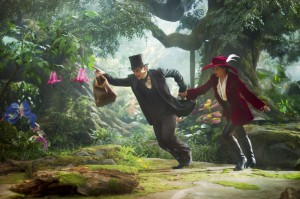Though not fully satisfying as a prequel of sorts to Wizard of Oz, the 1939 classic and beloved cult movie, Oz the Great and Powerful is sporadically vivid and quite enjoyable, especially for very young viewers.
Grade: B- (**1/2* out of *****)
As a rethinking of a popular fantasy fable, Sam Raimi’s feature is superior to Bryan Singer’s big, lousy, and noisy Jack the Giant Slayer, which is in current release and may suffer from the box-office appeal of the new “Oz the Great and Powerful.”
Inevitable, perhaps unfair, comparisons will be made to MGM’s legendary picture, directed by Victor Fleming, which has become indelible for many different reasons, both filmic and extra-filmic.
Among other things, that 1939 made Judy Garland a super star and forever entered into American folklore as an integral part of our collective consciousness as the definitive offering of childhood fears and anxieties, buy also dreams and fantasies. Disney’s fantastical adventure “Oz The Great and Powerful,” directed by Sam Raimi, is likely to divide critics, just as that studio’s “Alice in Wonderland” did a couple of years ago, though the latter went on to become a blockbuster, shockingly grossing over $1 billion at the global box office.
Famous author L. Frank Baum wrote 14 novels between 1900 and 1920, all set in the Land of Oz, which he vividly created. But he never fully portrayed the wizard character’s background in any of his books, which, of course, was fascinating for the filmmakers but also presented challenges that are only partially met.
This Oz unfolds as an origin story, a prequel, centering on how the wizard came to be the magical character that he is. The narrative itself, credited to Mitchell Kapner and David Lindsay-Abaire, is structured as a journey of recognition and knowledge—both of self and others.
While Raimi is not Tim Burton, he is a skillful director, responsible for revitalizing the “Spider Man” comic strip with three successful pictures, and here he is also using his background in the horror genre to emphasize the darker elements of the fairytale, while not neglecting the comedic and fantasy ones.
Overall the movie belongs to the three women, or rather witches, played by Rachel Weitz, Michelle Williams, and Mila Kunis. It’s easy to see why James Franco was not the studio’s or the director’s first choice. The titular part was offered and turned down by Robert Downey Jr. (“The Avengers”) and Johnny Depp (“Älice in Wonderland”), both of whom would have given a stronger, more commendable performance. Franco is appealing but he does not act as a superstar—which the role calls for. You can see why he has not become a major star, despite boasting sharp intelligence and impressive dramatic and comedic skills. Instead of owning a role and claiming it as his own, he disappears in it (and its costume and makeup), a strategy that worked well for “127 Hours,” but not here. Franco is a cool, postmodern actor, who applies cynicism and self-mockery to his screen roles (“Planet of the Apes”), but he always maintains distance. In this reimagining of the origins of L. Frank Baum’s beloved wizard character, Franco plays Oscar Diggs, a small-time circus magician with dubious ethics, to ay the least.
Things change when he is hurled away from gray and dusty Kansas to the vibrant Land of Oz. Initially, Diggs thinks he’s the luckiest fellow on earth, deluding himself that he has hit the jackpot–fame and fortune. But that feeling is shattered when he meets three witches, Theodora (Mila Kunis), Evanora (Rachel Weisz) and Glinda (Michelle Williams). Though different in many significant ways, all three itches challenge Diggs—they are not convinced that he is the great wizard everyone’s been expecting, demanding evidence and proof. As a result, he becomes a reluctant “hero”–drawn into the epic-size problems facing the Land of Oz and its diverse inhabitants.
The biggest, almost impossible but necessary, task is to be able to distinguish forces of good from those of evil before it is too late. Thus begins the main—and most entertaining—part of the narrative, which depicts how he puts his magical arts to use through illusion, ingenuity, and wizardry that would make Harry Potter and is cohorts envious. In due process, Oscar transforms himself not only into the great wizard, but also into a better human being. The message, while in tune with Disney’s long tradition of fables and animation features, is laid pretty heavy in the last reel. Raimi will be criticized for this 3D version, but considering the various pressures and challenges he faced, he has navigated shrewdly a very tricky ground. To put it bluntly, Raimi knew he had to make a film close enough, and with many references, to the 1939 picture, but not too close or imitative, as the studio doesn’t own the rights to that movie, which MGM is very protective of. On the other hand, Raimi realized that no matter what he did, he would be accused of a parasitic approach, as this “Öz” simply could not exist with MGM’s “Wizard of Oz.”
Finally, not to forget that the star of the 1939 is the inimitable Judy Garland, playing a vulnerable teenager, whereas the star of this picture is the moderately talented James Franco!
Credits
MPAA: PG
Running time: 127 Minutes.
Directed by Sam Raimi
Screenplay: L. Frank Baum, Mitchell Kapner, David Lindsay-Abaire




